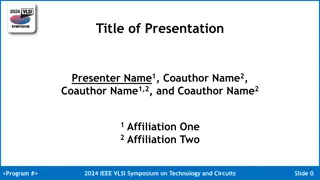
Insights into Enhancing Employment for People with Disabilities
Discover key takeaways from a program discussing effective strategies for recruiting and working with individuals with disabilities in the workforce. Learn about proactive recruitment, partnerships with disability organizations, and collaboration with state vocational rehabilitation agencies to fill job positions successfully.
Download Presentation

Please find below an Image/Link to download the presentation.
The content on the website is provided AS IS for your information and personal use only. It may not be sold, licensed, or shared on other websites without obtaining consent from the author. If you encounter any issues during the download, it is possible that the publisher has removed the file from their server.
You are allowed to download the files provided on this website for personal or commercial use, subject to the condition that they are used lawfully. All files are the property of their respective owners.
The content on the website is provided AS IS for your information and personal use only. It may not be sold, licensed, or shared on other websites without obtaining consent from the author.
E N D
Presentation Transcript
Todays Program Opening Remarks and Introductions Elaine E. Katz, MS, CCC-SLP, Senior VP, Grantmaking and Communications, Kessler Foundation Survey Introduction, Methods, Results, and Implications Andrew Houtenville, Professor of Economics and Research Director, Institute on Disability, University of New Hampshire John O Neill, PhD, Director, Center for Employment and Disability Research, Kessler Foundation Question and Answer Period
Quick Notes about Survey Methods Source of Sample: Qualtrics Business-to-Business panel, rather than contacting businesses directly which yields very, very low response rates. Sample Size: N=813 supervisors Added New/Innovative Questions: Asked to think and report about experiences with two specific employees: Worker X, who successfully performed their job functions, Worker Y, encountered challenges when performing their job functions.
Key Takeaway #1 Proactively recruiting workers with disabilities works. 50% of successful workers were recruited proactively, compared to 36% of workers that faced challenges Yet only 26% of supervisors reported that their company have policies to proactively recruit people with disabilities. 50% 36% Successful (Worker X) Faced Challenge (Worker Y)
Key Takeaway #2 Working with disability organizations and VR agencies is a promising strategy for filling jobs. 59% reported their companies worked with (partnered with or sought assistance from) disability organizations 59% 84% Effective/ very effective 84% of which reported doing so was effective/very effective. Worked with disability orgs
Key Takeaway #3 Working with state vocational rehabilitation (VR) agencies is a promising strategy for filling jobs. 48% reported their companies worked with state VR agencies 48% 78% Effective/ very effective 78% of which reported doing so was effective/very effective. Worked with state voc. rehab.
Key Takeaway #4 Workplace accommodations play an important role in the employment of people with disabilities. 78% 63% 63% 78% reported their companies had formal accommodations process Very effective Very easy 63% of which reported doing so was very effective, and 63% of which also reported it was very easy to use. Formal accom. Process
Key Takeaway #5 Upon Request Accommodations are frequently offered automatically or upon request, especially those that alter the job. 92% offer flexible schedule, 86% offer modified duties, 81% offer task shifting, 66% offer job sharing, But some more automatically offered... Automatic 37% 53% 48% 38% 54% 24% 34% 33% 28% 11% Flexible schedule Modified duties Task shifting Job Remote work sharing
Key Takeaway #6 Upon Request Automatic Accommodations that assist in performing duties are also frequently offered. 71% offer involvement for personal assistant services, 72% offer assistive devices, 63% offer job coaches, But automatically offered less frequently... 42% 44% 34% 29% 28% 27% PAS Assistive devices Job coaches
Key Takeaway #7 Assisting performance is more effective than altering the job. Compared accommodation types used by Worker Xs (successful) and those Worker Ys (faced challenges). 1.1 Successful workers were 1.1 times more likely to have a flexible schedule as an accommodation than workers that faced challenges. Worker X (Successful) (N=362) Worker Y (Faced challenge) (N=272) 68% 63% 1.1 48% 43% 1.4 1.0 30% 1.5 1.0 0.8 24% 24% 1.3 21% 17% 14% 14% 12% 10% 11% 9% 7% Flexible schedule Modified duties Task shifting Job sharing Remote work PSA Assistive Device Job Coach
Key Takeaway #7 (revealed) Assisting performance is more effective than altering the job. Compared accommodation types used by Worker Xs (successful) and those Worker Ys (faced challenges). 1.1 Successful workers were 1.1 times more likely to have a flexible schedule as an accommodation than workers that faced challenges. Worker X (Successful) (N=362) Worker Y (Faced challenge) (N=272) 68% 63% 1.1 48% 43% 1.4 1.0 30% 1.5 1.0 0.8 24% 24% 1.3 21% 17% 14% 14% 12% 10% 11% 9% 7% Flexible schedule Modified duties Task shifting Job sharing Remote work PAS Assistive Device Job Coach
Questions and Answers Use Q&A button on Zoom Slides will be archived at: Take our feedback survey at www.researchondisability.org/ntide/ntide-survey
Thank You! Information about the nTIDE partners may be found at Kessler Foundation (www.kesslerfoundation.org) UNH/Institute on Disability (www.ResearchOnDisability.org) AUCD (www.AUCD.org) Contact us at Email: Disability.Statistics@unh.edu Call: 866-538-9521 (toll free) Twitter at #nTIDELearn
KF-NEDS Series 2015 KF-NEDS: Workers with Disabilities 2017 KF-NEDS: Supervisor Perspectives 2019 KF-NEDS: Recent College Graduates 2022 KF-NEDS: Supervisor Perspectives and COVID-19 Pandemic 2024 KF-NEDS: Supervisor Perspectives in the Hospitality Industry
Characteristics of the Sample Sample drawn from the Qualtrics Business-to-Business panel. Analytic sample of 3,797 supervisors with experience supervising workers with disabilities. 52% between 35-50 years old . 55% male . 74% white . 71% college degree or higher . 78% working for private, for-profit . 48% had experience supervising people with disabilities. #KFsurvey2022






















